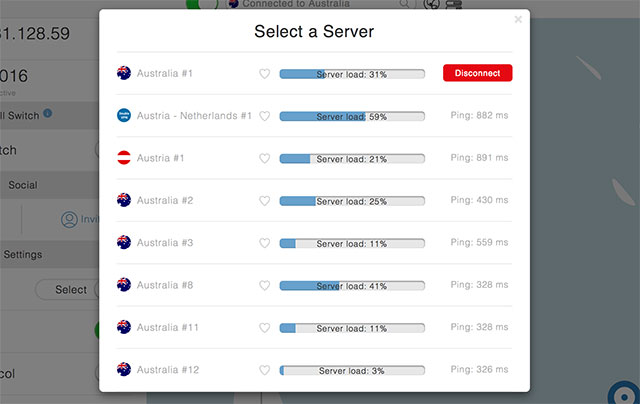

Virtual private networks (or VPNs, for short) protect your privacy by encrypting Internet traffic, and allow access to region-locked services like BBC iPlayer or Hulu from anywhere in the world.
We’ve talked about why NordVPN is a sound choice of VPN in the past, and today we’re looking at their brand new Mac app. The software, which has been in development for some time now, makes accessing the Internet via VPN on your Mac easier than ever before.
But first, you’ll need a NordVPN account.
Not every VPN provider has built a service-specific app, so let’s take a look at what all the fuss is about.
Quite simply, the NordVPN Mac app provides a simple and easy-to-use interface for using the NordVPN service with Mac OS X. The app has been built specifically with NordVPN in mind, and as such cannot be used with any other VPN providers.
This has its benefits, of course. If you’ve used one of the many VPN clients out there, you’ll likely be familiar with the process of supplying your credentials for each new server you need to connect to. You probably stick to the same server all the time, paying little attention to server loads — maybe you don’t even realise you’ve got a choice of servers for your region.

Well with NordVPN’s Mac app, you can access multiple servers and view a wealth of information about the service simply by logging in once. Furthermore, you can actually view server loads at-a-glance using the included server list, which provides you with the current ping (server latency) and the server load displayed as a percentage.
That said, connecting to your chosen region is much less of a guessing game using the official app. The software decides — based on your location, current latency and server load — which server to automatically connect you to, and you can specify personal favourites if you really want to. This is all presented on an actual map, removing the need to trawl through a long list of servers you probably never use.

Connecting to a region is a one-click affair — the only other thing you’ll need to do is authorise the app with your root password in order to make changes that affect how your Mac routes your Internet traffic. The app sits between your Mac and the outside world, and even allows you to automatically connect to your favourite server when you turn your Mac on.
From time to time, the connection between your Mac and the VPN server will drop. When this happens, your computer will revert to transmitting information in its regular unencrypted state which could put you at risk.
That’s where an app-specific feature called Kill Switch comes in. When enabled, Kill Switch prevents certain apps from accessing the Internet as soon as the VPN connection drops. This makes information leak — at least from the apps that you specify — virtually impossible. You can enable the feature with the click of a button, and specify the apps directly from your Applications folder in a few clicks.

This feature has been restricted to a user-specific list of apps for a reason. You might not want iMessage (which encrypts everything by default) or Slack to be interrupted in case of a dropout. Keep in mind certain apps (like your web browser or company-specific software) transmit sensitive information which could be compromised during the short time it takes to reconnect to the server.
If you’d like to be really clever about this, you can use an app called Fluid (free) to turn mission-critical websites into their own apps, which can be pinned to your dock for quick access — think banking websites, webmail, Evernote’s web client. By adding these apps to your VPN Kill Switch (and restricting your use of the services to the apps you created) you can prevent vital information leaks without restricting your entire web browser.

One thing I’ve noticed since getting a VPN account is that I frequently forget to use it. Auto-connect solves this problem, and you can check if you’re connected simply by glancing at the Mac menu bar icon, which changes color based on your current connection status (green if you’re connected, red if you’re not).
Unless you’ve got a very specific VPN connection to make (like literally one server) then you’ll want a dedicated VPN client for your Mac. There are many free solutions out there (TunnelBlick is a personal open source favourite) but very few of them meet the “user-friendly” criteria, display server loads or simplify connecting to regions with a map.

If you’re sick of wrestling with unsightly menus, inputting your credentials each time you connect to a new server and not being able to tell which server has the lowest latency or isn’t under heavy load, you should download NordVPN’s Mac app instead. And don’t forget to sign up for a plan.
Download: NordVPN for OS X
Will the app make you switch to NordVPN? What other VPN software do you use on OS X?




 Dragon Ball XenoVerse Guide: How to Unlock All Characters
Dragon Ball XenoVerse Guide: How to Unlock All Characters Mortal Kombat X Guide: How to Play Johnny Cage
Mortal Kombat X Guide: How to Play Johnny Cage Diablo 3: Ultimate Evil Edition Xbox Achievements List
Diablo 3: Ultimate Evil Edition Xbox Achievements List Fallout 4: Infinite Special Points Glitch On PS4 and Xbox One Discovered
Fallout 4: Infinite Special Points Glitch On PS4 and Xbox One Discovered Thief Wiki – Everything you need to know about the game .
Thief Wiki – Everything you need to know about the game .